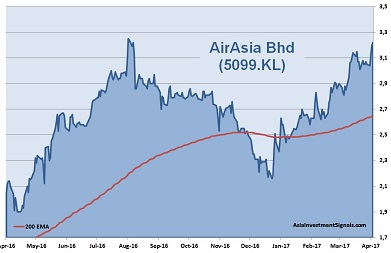 AirAsia Berhad (5099.KL) is Asia’s largest low-cost carrier in term of fleet size and passenger numbers and the fourth largest airline in the continent. The company provides passenger and air cargo services on short-haul, point-to-point domestic and international routes.[mepr-active membership=”1734″ ifallowed=”show” unauth=”message” unauth_message=”Please login or purchase a membership to view full text.”] From once a two-plane operation in Malaysia, AirAsia has become the leading low-cost airline with more than 170 planes in Asia. Through its regional affiliates Thai AirAsia, Indonesia AirAsia, Philippines AirAsia and AirAsia India and its AirAsia X unit for low-cost, long-haul global flights the company is serving over 222 routes and connecting 110 destinations across 20 countries.
AirAsia Berhad (5099.KL) is Asia’s largest low-cost carrier in term of fleet size and passenger numbers and the fourth largest airline in the continent. The company provides passenger and air cargo services on short-haul, point-to-point domestic and international routes.[mepr-active membership=”1734″ ifallowed=”show” unauth=”message” unauth_message=”Please login or purchase a membership to view full text.”] From once a two-plane operation in Malaysia, AirAsia has become the leading low-cost airline with more than 170 planes in Asia. Through its regional affiliates Thai AirAsia, Indonesia AirAsia, Philippines AirAsia and AirAsia India and its AirAsia X unit for low-cost, long-haul global flights the company is serving over 222 routes and connecting 110 destinations across 20 countries.
AirAsia was founded in 1993 and is headquartered in Sepang, Malaysia. The company is listed on the main board of Kuala Lumpur’s Stock Exchange since November 2004. Around 65% of AirAsia’s shares are in public hand. 38% of the shares are held by the two active founders directly and indirectly.
Airlines are expected to enjoy another good year in 2017 according to latest estimates from IATA. Profitability has improved significantly with oil prices falling up to 50% from the highs of 2014. Increasing per capita income, increasing affordability through low-cost carriers and the propensity to travel will continue to drive traffic growth, particularly in Asia. Passenger traffic is forecasted to grow by around 6.1% CAGR till 2035 in the region. Liberalization and policy initiatives like open skies and easing of visa regulations are also driving the traffic expansion.
In this favorable economic context, AirAsia is accelerating expansion to better reach its target population of some 4.4bn people with the acquisition of new aircraft and new hubs in Japan and Vietnam. After significant improvements in profitability, the company is confident to pursue a faster and more strategic growth. However, intensifying competition, currency volatilities, and increasing fuel prices may pressure yields.
With a workforce of 6,300 employees, AirAsia reported revenues of 6.9bn MYR (1.6bn USD) and a profit before tax of 2.2bn MYR (491m USD) for 2016. An increase of 10% and 907% respectively on a year-on-year basis. In 2015 revenues and profits were up 16% and 848% respectively compared to the year before. AirAsia’s cash reserves at the end of 2016 have been 1.7bn MYR (395m USD). The equity ratio is at 30% while gearing, defined here as total liabilities to total equity, is at 231%.
AirAsia’s shares are in an uptrend since August 2015 and gained 260% in value since, 37% alone this year. The company is still reasonably priced at only four times earnings, compared to 28 times among its sector peers. AirAsia trades currently just slightly above book value and at only four times cash flow. The last dividend payments yielded almost 4%. 18 out 23 covering analyst rate the company as buy or outperformer.
We expect AirAsia to gain further market share in Asia and to increase profitability with the consolidation of its different operations. A stable economy in Asia and a still relatively low oil price will have positive effects on margins. The shares have a good chance to reach at least old highs at 3.90 MYR by the end of this year, a gain of 20%.
AIS Rating: ★★★★☆
| 2011 | 2012 | 2013 | 2014 | 2015 | 2016 | |
|---|---|---|---|---|---|---|
| EPS (MYR) | 0.2 | 0.66 | 0.13 | 0.03 | 0.19 | 0.73 |
| Change | -47% | 230% | -80% | -77% | 533% | 284% |
| P/E | P/E SECTOR |
P/B | P/CF | Equity Ratio* |
ROE | Debt/ Equity** |
Div YLD |
|---|---|---|---|---|---|---|---|
| 4 | 28 | 1.3 | 3.7 | 30% | 37% | 231% | 4% |
* Equity / Total Assets, ** Total Liabilities / Equity
[/mepr-active]
